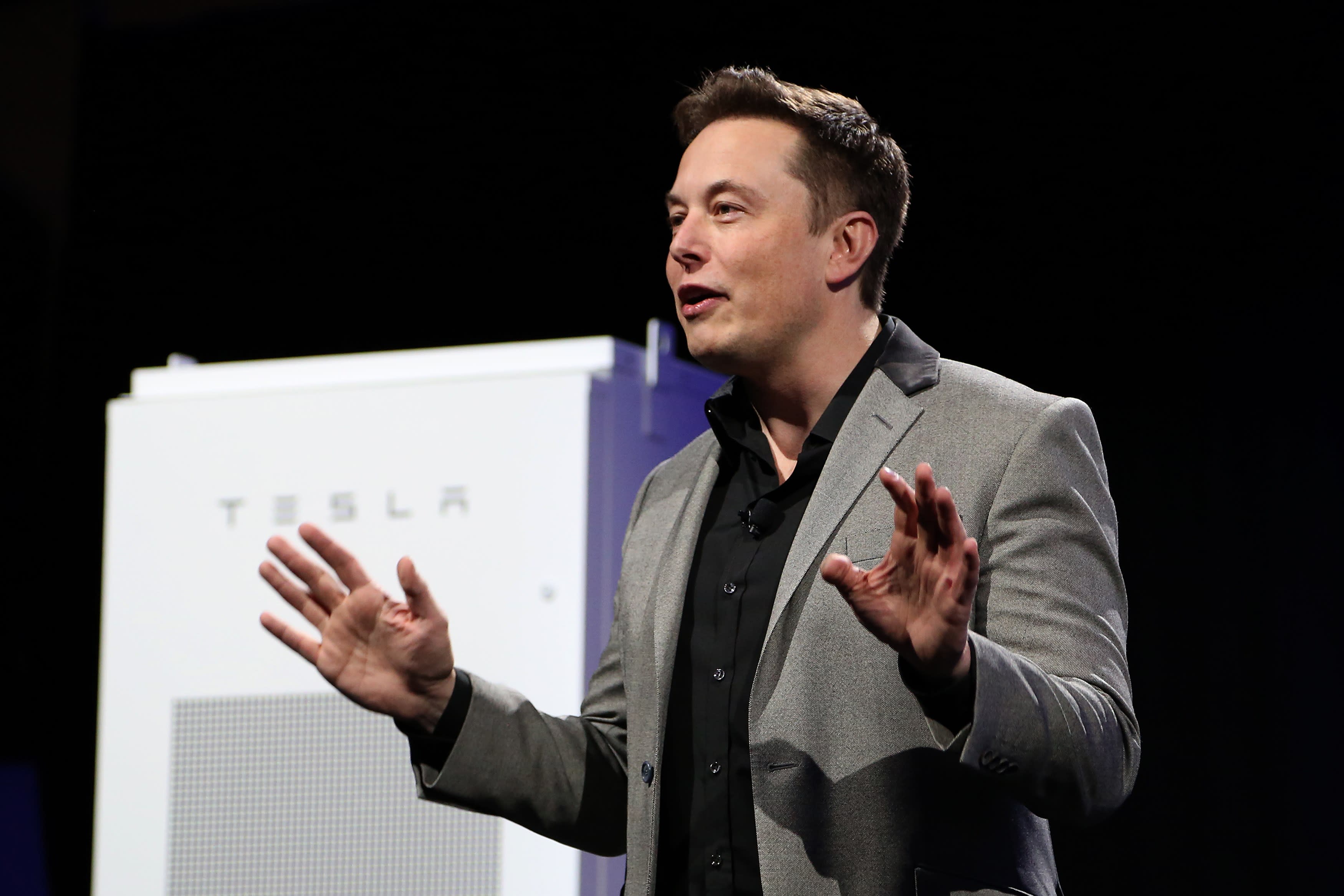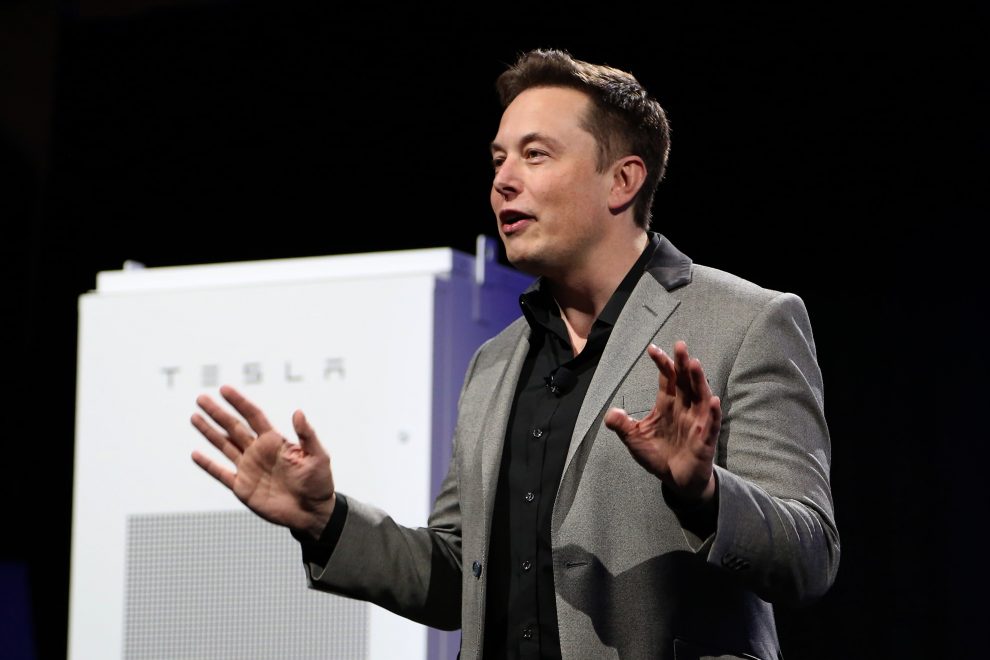
Tesla Motors CEO Elon Musk unveils large utility scale home batteries at the Tesla Design Studio in Hawthorne, California.
David McNew | AFP | Getty Images
Tesla shares surged on Wednesday after what Barclays’ called the company’s “impressive” record quarterly deliveries number, but Wall Street analysts largely remain cautious, focused on the upcoming second-quarter earnings report.
The electric vehicle maker reported delivering 95,200 cars during the second quarter, beating Tesla’s previous record of 90,700 deliveries, which happened in the fourth quarter of 2018. The result also beat Wall Street’s expectation of 91,000 deliveries, according to analysts surveyed by FactSet, but met the expectation of a record quarter set by CEO Elon Musk last week.
“The Q2 delivery beat does not change our cautious view on Q2 earnings,” UBS said in a note to investors.
Despite the banner result, which sent Tesla’s stock up nearly 7% in premarket trading, analysts largely left estimates for the company’s 2019 earnings and revenue unchanged. RBC cautioned investors that Tesla did not update or reiterate its 2019 forecast, which the company did in the first quarter of this year.
Goldman Sachs said it continues “to expect some sequential stepdown in demand and ultimately deliveries as we progress into 3Q19,” the firm said.
Even firms with the most optimistic view on Tesla’s future, such as Baird, told investors to focus on the company’s upcoming second-quarter earnings report. Tesla is expected to report earnings on Aug. 7.
“We think Q2 earnings will be the next catalyst to restore confidence and reattract investors to the name,” Baird said. “We continue to like the set-up and believe there are several catalysts upcoming which will contribute to a challenging short environment.”
Here’s what every major analyst said about Tesla’s deliveries.
Goldman Sachs’ David Tamberrino: Sell rating, $158 price target
“We continue to focus on the sustainability of demand for the company’s products — particularly as we believe 2Q19 deliveries and order flow was helped by the company’s release of its Standard Model 3 variant, a leasing option, and right-hand drive Model 3s (see our note, Where do we go now?); further, demand in the US was likely aided in 2Q19 by the looming second step in the phase out of US Federal Tax Incentives for TSLA vehicles that began on July 1. As a result, we continue to expect some sequential stepdown in demand and ultimately deliveries as we progress into 3Q19.”
UBS’ Colin Langan: Sell rating, $160 price target
“The Q2 delivery beat does not change our cautious view on Q2 earnings. Price reductions, the wider availability of cheaper versions of the Model 3, and the phase out of the US EV tax credit ($1,875) helped Q2 deliveries. The price cuts will likely result in margin pressure. Based on the higher than expected deliveries, we are raising our Q2 EPS estimate to -$0.17 from -$0.78; we expect consensus estimates will be revised similarly.”
J.P. Morgan’s Ryan Brinkman: Underweight rating, $200 price target
“The magnitude of 2Q loss and amount of FCF generated in the quarter will now be key to watch, particularlyas we estimate the firmmay have undertaken premium costs to meet delivery targets. The debate will also likely turn to sustainability of demand given that 2Q was, like 4Q18, a pre-buy quarter in the US ahead of another step-down in availability of federal tax credits on July 1. We are raising our 2Q estimates today, although not our subsequent period forecasts, given no change to full year guidance of 360-400K.”
Baird’s Ben Kallo: Outperform rating, $355 price target
“Extremely strong deliveries beat even whisper numbers and set the stage for strong Q2 results, in our view. The release is a positive step in the recovery process for the TSLA narrative, and we think Q2 earnings will be the next catalyst to restore confidence and reattract investors to the name. We continue to like the set-up and believe there are several catalysts upcoming which will contribute to a challenging short environment, including the upcoming Q2 report and volume/earnings growth in 2H. … We think a cash flow positive quarter is certainly achievable, particularly if working capital headwinds in Q1 unwind and/ or CapEx comes in lower than we forecast (we currently model $625M).”
Barclays’ Brian Johnson: Underweight rating, $150 price target
“We credit Tesla for the impressive delivery beat- ahead of Street expectations even after the intra-quarter delivery updates via Elon’s leaked emails (link). However, as we wrote last week Tesla, Inc.: First things first, move the metal (06/27/2019), while deliveries very well may surprise to the upside, Tesla’s incentives are fiercely bent on maximizing deliveries to focus on cash generation, likely at the expense of profitability. Moreover, with the potential for future capital raises (maybe as soon as next year) the need to maintain an accelerating growth narrative is now more important than ever. We continue to expect a loss this quarter as well as a challenging sales/profit environment for the remainder of the year as the EV tax credit drops and ASPs dampen from increasing shifts away from its S&X models.”
Morgan Stanley’s Adam Jonas: Equal-weight rating, $230 price target
“While there were a good amount of “leaked” emails and reports prophesizing a potential “record quarter” for deliveries, we had not spoken to any investors that expected deliveries to be this high…Based on reported deliveries YTD, if TSLA were to deliver 95k units in Q3 and Q4 that would put them at approximately 350k units for 2019, just shy of their full-year guidance of 360k-400k units.”
Bernstein’s Toni Sacconaghi: Market-perform rating, $325 price target
“We believe that Tesla has a shot at being profitable this quarter on a non-GAAP basis, even with materially pressured automotive gross margins … We estimate that the US accounted for nearly 70% of Model 3’s sold this quarter, vs. <50% in Q1, suggesting that US sales may have been boosted by the expiring Federal tax credit this quarter, and that Tesla could be challenged to meet its full year deliveries bogey … Tesla stated that it will no longer report vehicles in transit – we worry that it will be more difficult for investors to monitor true underlying demand in a given quarter.”
Credit Suisse’s Dan Levy: Underperform rating, $189 price target
“Assuming Tesla maintains its ’19 delivery guide, it would imply min. 2H deliveries of just over ~200k units. We believe this may be tough to achieve, and model 2H deliveries of ~180k, esp. as Tesla will still need to work its way through another cut to the US EV tax credit … Into 2Q EPS the focus will be on gross margin and FCF. As part of its delivery release Tesla highlighting “cost efficiencies” and improvements in working capital through streamlined global logistics and delivery ops. We model positive 2Q FCF, primarily related to positive working capital.”
Bank of America’s John Murphy: Underperform rating, $225 price target
“As a reminder, TSLA continues to forecast losses in 2Q, although improved from 1Q:19 levels, with a return to profitability in 3Q:19, as deliveries inflect higher and cost reduction initiatives take effect. However, we would note that TSLA faces an element of mix degradation into 2H:19+ as lower-priced Model 3 variants begin to comprise a larger portion of volume, which will likely pressure margins, profits, and cash flow … short interest (in terms of amount of shares) hit an all-time high of 44mm (~33% of the float) at the end of May, although days to cover remains balanced and stock borrow still liquid due to trading volume. In our view, this could set up for a short squeeze, as 2Q:19 deliveries were slightly ahead of more pessimistic Street.”
Nomura Instinet’s Christopher Eberle: Neutral rating, $300 price target
“Tesla’s 2Q vehicle deliveries (95,200) reached the mid-point of the company’s guidance range, something that we believe many investors considered unlikely earlier in the quarter. Model 3 deliveries of 77,550 exceeded our 70,135 estimate and consensus of approx. 70,500. Models S and X were also ahead of expectations. Tesla only provided a combined 2Q delivery figure for the two models (17,650), but we estimate Model S deliveries were approx. 8,500, above our prior forecast of 7,822. For Model X, we estimate approx. 9,000, roughly in line with our prior estimate.”
RBC Capital Markets’ Joseph Spak: Underperform rating, $190 price target
“The unit numbers are better than expected and the stock is up ~7% after-market which we believe could be close to a near-term top. The next catalyst is earnings where the focus will shift to auto gross margins, cash flow and sustainability of demand … While 2Q19 units were better, we still caution 1) that mix of vehicles (and discounting to move units) could weigh on profitability and hence 2Q19 likely sacrificed margins for units. We find the company’s intense focus on hitting short-term targets somewhat curious for a story supposedly long-term focused, and 2) the strong push at the end of the 2Q19 could have pulled forward some demand … Of note, Tesla did not reaffirm guidance as they did in the 1Q19 delivery release.”
Macquarie Research’s Maynard Um: Outperform rating, $400 price target
“TSLA’s sequential increase in order backlog should also further support deliveries going into H2 and we expect further Model S&X refreshes and lower-priced variants of the Model 3 to drive continued demand through at least the remainder of the year. We then expect China demand to grow as the Shanghai factory ramps up production starting in Q4 and accelerates in FY20 H1.”
Evercore ISI’s Arndt Ellinghorst: Sell rating, $200 price target
“While we will revisit our Q2 Rev/Mgn/FCF, we remain comfortable with our FY unit estimate of 345k (implying TSLA can stay in the ~90k/Q range but likely struggles to move higher), given continued questionable global M3 demand (SR+ Q2 initial push now behind) and continued concerned around S/X mix (21% YoY; 15-16k per Q 1H trend). Although a solid bounce back vs disastrous Q1, price/mix will remain a significant gross margin sequential headwind for the rest of the yr, and we have yet to see a material move up from 5-6k/week M3 production (target is 7k by end of the year).”
– CNBC’s Michael Bloom contributed to this report.









